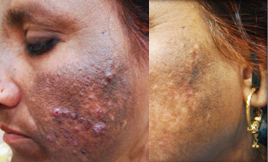Skin Rejuvenation, Treatment of Melasma, Acne and Acne induced dyschromias

Chemical Peels also known as skin polishing is a technique of exfoliation, used to smooth rough & dry skin. The topmost layer of the skin which is damaged by sunburn, pigmentation, scarring from spots is removed by this technique. Chemical peels also have some therapeutic effect such as it is used to treat melasma (Dark skin pigmentation during pregnancy), as well as precancerous conditions i.e keratosis. Chemical peels are one of the most popular procedures which allow new layers of skin to be exposed, resulting in a noticeably youthful, fresh appearance, smoother and clearer complexion. Chemical peels are categorized based on the depth of the procedure: superficial, medium or deep. Peel ingredients vary and can include
Glycolic Peel
Glycolic peels are painless and safe skin exfoliation process that removes a micro-thin topmost layer of the skin. The term glycolic peels are derived because of the use of Glycolic Acid (Alpha Hydroxy Acid (AHA)) in this treatment. Glycolic acid is a chemical generally non-toxic exfoliant naturally found in sugar beets, unripe grapes, and sugarcane. In contrast to the TCA (Trichloroacetic acid) Peel, which can penetrate deep into the dermis, the Glycolic Acid Peel dissolves the uppermost layer of the epidermis results in revealing fresh, smooth skin.
Glycolic Acid is a very popular skin peeling treatment which is gentle and has little or no downtime as compared to other stronger peels such as Jessner and TCA (Trichloroacetic acid). The exfoliating effect of the glycolic acid promotes regeneration of healthy skin and results increased hydration of skin tissues. Chemical peel treatment works against a number of typical skin ailments such as fine lines, wrinkles, skin pigmentation, and clogged pores. This treatment act by the break down of the dead, mature layers of pore-clogging proteins and lipids to reveal more sooth, youthful & healthy skin. It also helps reduce and dislodge ingrown hairs.
Before the treatment begins, a skincare specialist will choose a glycolic acid peeling solution and find out the potency or strength of that solution ranging from light (20%-30%) to medium (40%-500%) to deep (60%-70%). The peeling solution is gently applied then left on the skin for a few minutes defending begins on the desired results and your tolerance and reaction to the AHAs. A slight tingling or itching for 2-3 minutes will be experienced, but the process should not cause any pain or discomfort. A temporary and less common stinging and itching effect, minor skin redness and skin sensitivity has been noted upon initial contact. These effects will fade within a couple of hours, once the peel is neutralized. An antioxidant sunscreen spray STEPPIE MD® SPF 25 is then applied. This UVA/UVB daily sun protection spray is chemical free, provides moisture while protecting the skin from the sunburn, skin pigmentation by sun exposure, which is very important after a chemical peel. To assure safety and to get the best results, one needs to follow the post-treatment instructions provided by the clinical esthetician. Mild flaking could last from 5-7 days and may take longer depending on the potency used.
Sunburn Alert: Glycolic peel contains Alpha Hydroxy Acid (AHA) that may increase skin’s sensitivity to the sun and increase the possibility of sunburn. Using STEPPIE MD® Antioxidant Sunscreen Spray SPF 25 is highly recommended by us, which provides broad-spectrum protection from both UVA and UVB rays with no chemical sun filters. It contains Zinc oxide (FDA-approved physical blocker) which reflect light away from the skin. It should be applied 30 minutes before exposure and reapply often when exposed to the sun.